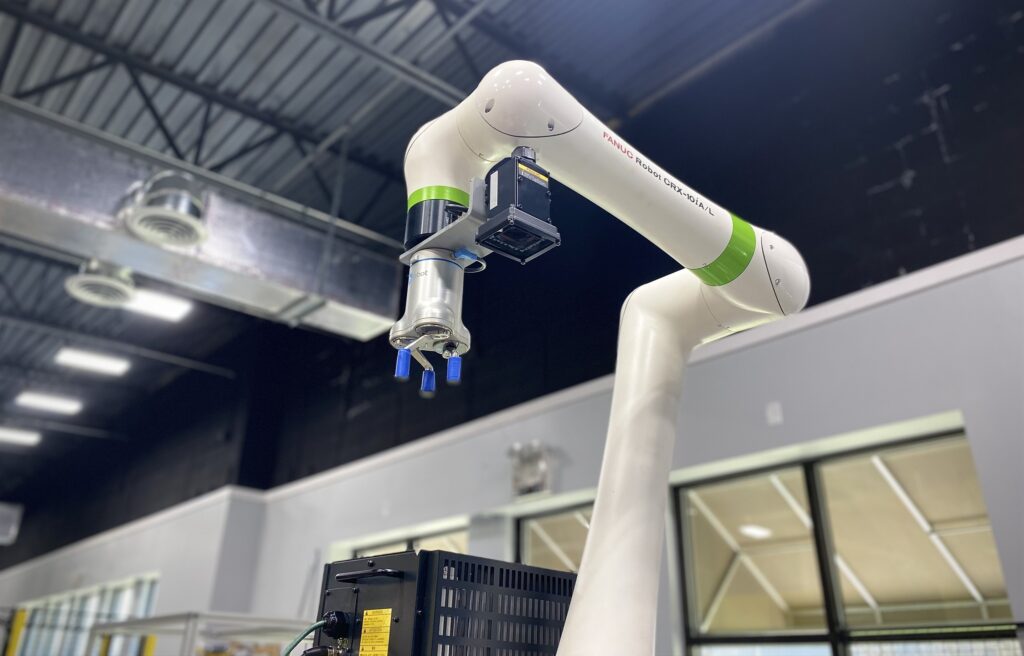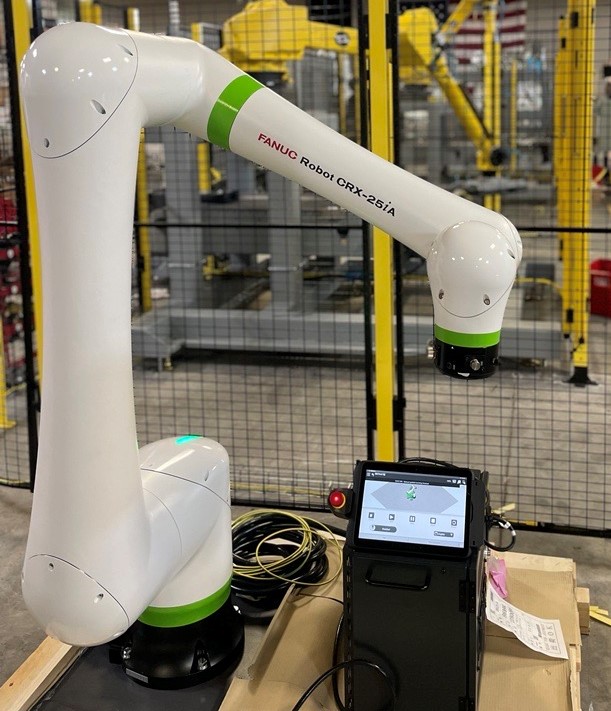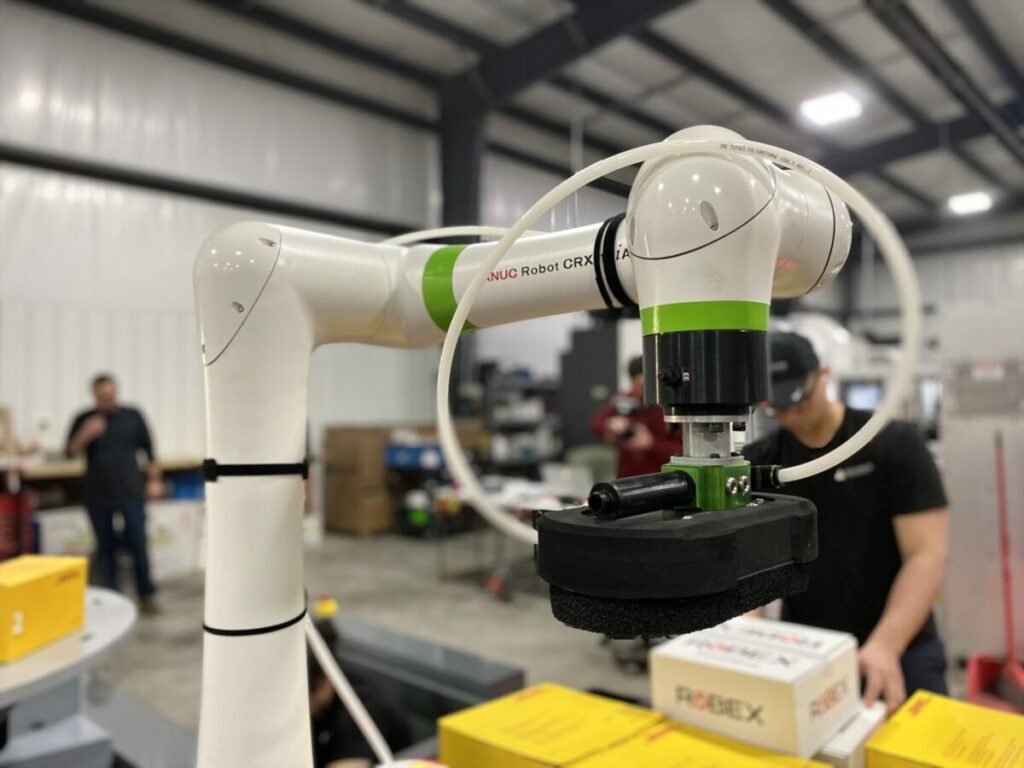 The rise of automation and robotics in the manufacturing sector has transformed how goods are produced, ushering in a new era of efficiency, speed, and precision. Robotics and automation technology are no longer futuristic concepts—they’re becoming integral parts of modern manufacturing processes.
The rise of automation and robotics in the manufacturing sector has transformed how goods are produced, ushering in a new era of efficiency, speed, and precision. Robotics and automation technology are no longer futuristic concepts—they’re becoming integral parts of modern manufacturing processes.
However, the advent of collaborative robots, also called cobots, has opened up new paradigms in manufacturing, emphasizing the potential for human-robot collaboration. As industrial automation integrators, the RōBEX team has seen firsthand the transformative power of cobots and how they’re reshaping the manufacturing landscape by promoting teamwork and harmony on the factory floor.
Here’s how human-robot collaboration in manufacturing is helping companies excel.
A New Era of Manufacturing
The traditional image of a factory floor populated solely by human workers is evolving rapidly. Modern manufacturing environments increasingly utilize robotic arms and autonomous machines to execute tasks with precision and efficiency.
While these advancements have undeniably boosted productivity, the implications of human-robot collaboration in manufacturing are even more profound. Cobots represent an exciting development in this arena, as they are designed to work alongside human operators rather than replace them.
This approach has the potential to create a harmonious balance between robotic systems and human workers, allowing companies to leverage the strengths of each to enhance overall productivity.
Enhancing Safety and Ergonomics

Safety is a primary consideration when adopting robotic systems, especially in human-robot interaction. Fortunately, one of the primary advantages of a collaborative robot is its ability to improve workplace safety and ergonomics.
Traditional industrial robots were often confined to caged environments to protect human workers from potential accidents. In contrast, cobots are designed with built-in safety features that enable them to operate alongside humans without the need for extensive safety barriers. This means that workers can work alongside collaborative robotics systems nearby, leading to more seamless interactions and enhanced productivity.
Moreover, a collaborative robot can undertake physically demanding or repetitive tasks, reducing the risk of ergonomic injuries associated with these activities. In this way, cobots enable human workers to focus on higher-value tasks that require cognitive skills and decision-making abilities. This not only enhances the overall well-being of the workforce but also has the potential to drive substantial efficiency and productivity gains.
Flexibility and Adaptability
Among the benefits of cobots are their flexibility and adaptability within manufacturing environments.
Unlike traditional industrial robots, which often require extensive reprogramming and reconfiguration to accommodate new tasks, cobots are designed to be easily reprogrammable and customizable. This allows manufacturers to swiftly deploy cobots across various production lines or re-task them to meet changing demands, maximizing operational agility and responsiveness.
Furthermore, the collaborative nature of cobots facilitates seamless integration into existing workflows. Whether it’s assembling components, handling materials, or assisting in quality control, collaboration between humans and robots contributes to a more dynamic and adaptive manufacturing environment.
The Human-Tech Partnership
The emergence of cobots underscores the pivotal role of human-robot interaction in driving a more efficient and sustainable manufacturing industry.
Rather than viewing automation and robotics as a threat to job security, companies should recognize the potential for robotic systems to complement and enhance the capabilities of their workforce. The interaction between people and robots can augment productivity for both simple and complex tasks.
By fostering a culture of collaboration and training employees to work alongside cobots, organizations can harness the combined potential of human expertise and robotic precision for the industrial sector.
Training and Education
As the use of industrial robots and cobots becomes more prevalent in manufacturing, investing in training and education programs for employees will be critical.
Equipping workers with the skills and knowledge to effectively engage with cobots and control their operations can maximize the benefits of human-robot collaboration. Moreover, cultivating a deeper understanding of cobot capabilities and safety protocols will promote a cohesive and empowered workforce.
Safety is crucial when deploying both industrial robots and cobots for complex tasks and physical workloads, so training and education play an instrumental role in building secure robot collaborations and long-term success.
Ethical Considerations
 While the interaction between workers and cobots in manufacturing brings numerous advantages, it’s essential to address ethical considerations surrounding the deployment of robotics.
While the interaction between workers and cobots in manufacturing brings numerous advantages, it’s essential to address ethical considerations surrounding the deployment of robotics.
Companies must prioritize the well-being of employees when deploying cobots. This involves maintaining transparent communication channels, providing comprehensive training, and establishing clear protocols for human-robot interactions and robot collaborations.
As cobots continue to increase in manufacturing, it’s vital to uphold ethical best practices to safeguard the welfare of workers and promote harmonious coexistence between humans and robots on the factory floor.
Download Our eBook for Pick, Pack, and Palletizing Solutions
The transformative potential of cobots in manufacturing is undeniable. By fostering human-robot collaboration in manufacturing, these advanced technological tools have the power to revolutionize industrial tasks, leading to safer, more efficient, and adaptable manufacturing environments.
Curious about how your company can unleash the full potential of cobots and industrial robots to drive innovation? Download our eBook on pick, pack, and palletizing solutions to discover more!


 While the interaction between workers and cobots in manufacturing brings numerous advantages, it’s essential to address ethical considerations surrounding the deployment of robotics.
While the interaction between workers and cobots in manufacturing brings numerous advantages, it’s essential to address ethical considerations surrounding the deployment of robotics.